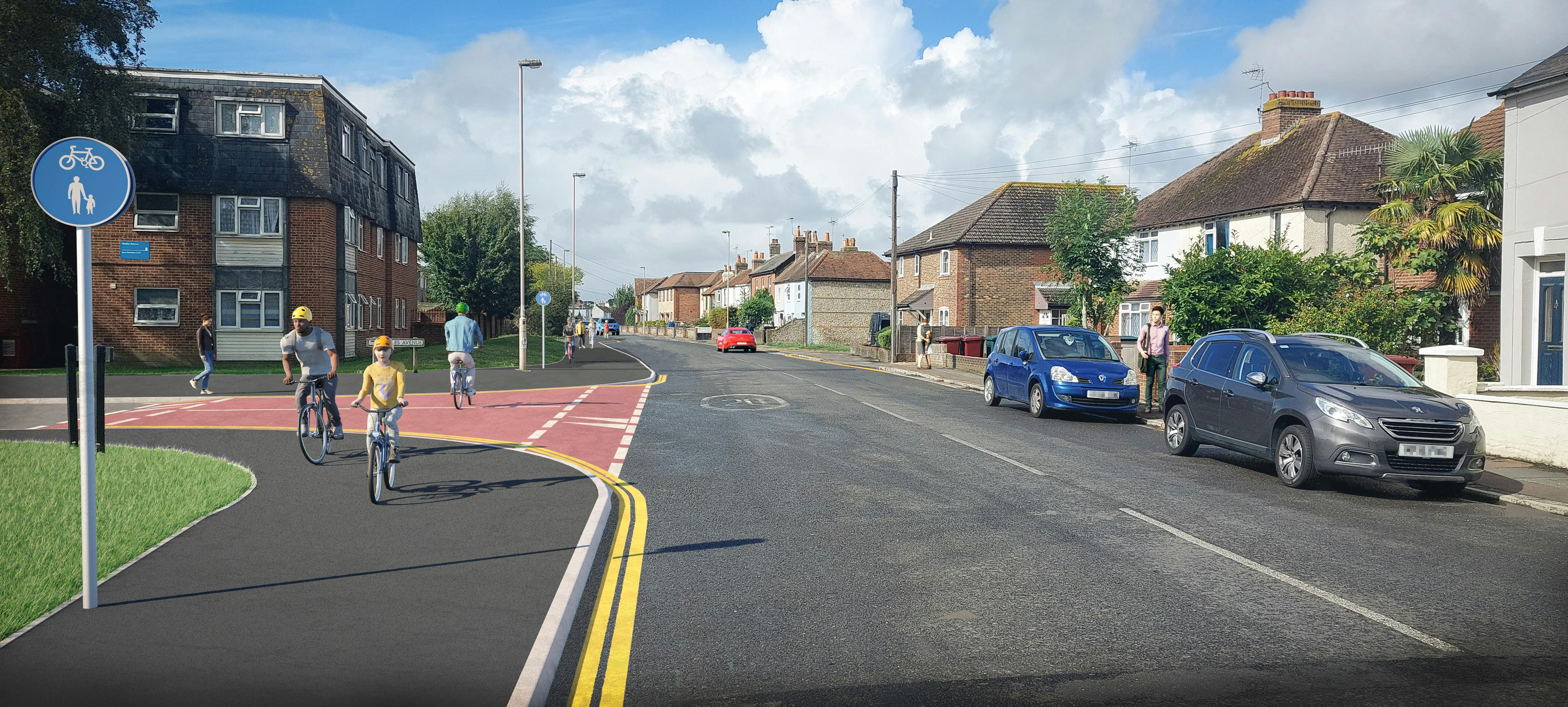FAQs
Why is the scheme required?
The West Sussex Transport Plan sets out an ambition to deliver sustainable transport improvements in Chichester, increasing connectivity and improving access to services and employment opportunities.
At present, cycling and walking facilities across the city are disconnected and to a poor standard. The road network is also heavily congested. This creates an intimidating environment for cyclists and pedestrians, creating safety concerns and reducing the attractiveness of these modes.
The proposed scheme would help address the above-outlined issues, through the delivery of improved walking and cycling facilities that would connect eastern areas of Chichester to the city centre.
The proposals align with the objectives set out in West Sussex Transport Plan and would support wider initiatives to develop the city.
How much will the scheme cost and how is it being funded?
At this early stage of design, a detailed costing exercise has not yet been undertaken. However, in order to be successful, the scheme would need to demonstrate good value for money, which walking and cycling schemes generally do.
An external funding stream would be used to deliver the proposals. Some sources of funding have already been identified through the Community Infrastructure Levy (CIL) and developers in the Section 106 Agreement. However, other sources would be needed in order to deliver the scheme.
Congestion is more of an issue in the area, why are you not improving this first?
It is hoped that by improving facilities for walking and cycling, more people would be encouraged to swap using their vehicles for more active modes as part of their daily journeys. The scheme would provide an important connection between areas to the east of Chichester, such as Tangmere and Shopwyke, to the wealth of employment and leisure facilities on offer in the centre of Chichester.
Are these options LTN 1/20 compliant?
The Government’s Local Transport Note (LTN) 1/20 provides guidance and good practice to local authorities for the design of high-quality cycle infrastructure.
We have designed a scheme that aims to deliver the highest level of provision that is possible within the constraints of the area. We believe this scheme best balances the needs of walkers and cyclists with those who need to park close to residential properties and businesses, and those who need to drive through the area.
Why can’t you convert all of Oving Road to one-way? That way you would be able to install two-way segregated cycle lanes along the entire route.
B2144 Oving Road is a key east-west corridor that links key areas of the city centre to the east of Chichester. This means the route is used for a variety of trip types such as commuting and leisure purposes. As such, if all of B2144 Oving Road were to be converted to one-way, major diversions would be involved on an already congested road network. This would therefore increase people’s journey times.
We have identified a section of Oving Road that we have suggested could be converted to one-way, which would enable a safer environment for cyclists, while limiting diversion routes.
We also need to maintain local access for residents, emergency services and deliveries without causing additional journey times.
Are you considering any bus priority measures/improvements to services?
As this scheme is primarily focused on improving facilities for walking and cycling, improvements to bus services will be funded separately. Back in December 2021 we published our Bus Service Improvement Plan (BSIP). This set out the ways in which we can improve bus services within West Sussex and increase the number of journeys made on buses after a decline during the Covid-19 pandemic.
The Department for Transport has provisionally awarded us up to £17.4 million of this BSIP funding. We are now looking to see how we can best spend this money on delivering the key elements of the plan.
Our proposals for B2144 Oving Road would complement any improvements to bus services within the city by allowing multi-modal journeys to take place via bus and bicycle.
Why are you not extending the scheme to the east of the A27 up towards Tangmere?
We are promoting a cycle route between Portfield and Tangmere as part of our on-going feasibility study for A285 Westhampnett Road. This has the opportunity to provide linkages to the wider network including Oving Road.
I can’t attend the in-person event but I want to speak to a member of the project team, what should I do?
There are a number of ways in which you can contact the project team. You can either email the team at STIPActivetravel@westsussex.gov.uk or you can telephone 01243 642105.
If the scheme is to go ahead, will there be road closures during construction?
Before any construction on the scheme starts, a Construction Management Plan will be published to minimise the impact on the local community as much as possible. This will detail any temporary road closures, along with changes to access for pedestrians and cyclists as well as diversion routes.
A Community Liaison Officer will also be appointed to regularly communicate with the local community on the progress and programme of the construction works.
Does the scheme require any land take / is my property at risk?
At this stage it is anticipated that the majority of the construction works can take place within the existing highway boundary or land owned by West Sussex County Council. However, land acquisition would be required to install a continuous footway across Chequers Place. All affected landowners would be contacted directly by the project team.
Should the land be unavailable, we would instead look to re-mark and redesign the existing path, maintaining its current form.

